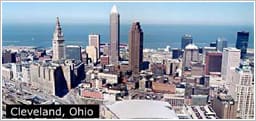Cleveland: The Incredible Shrinking City
This week, the U.S. Census released its latest population estimates for American cities. And for my old hometown of Cleveland, Ohio, the news was grim indeed. Now down to 444,000 people, the city that once proclaimed itself the "Best Location in the Nation" has lost over half its population since 1950.
There is simply no way to gloss over the cavalcade of catastrophic numbers for Cleveland. In 1920, Cleveland was the fifth largest city in the United States; today it is 40th. The devastation of the city's industrial base in steel, cars and heavy machinery is reflected in a precipitous population decline that accelerated in the 1970's. From its post-war peak of 914,000 in 1950, Cleveland dipped to 876,000 in 1960, 750,000 in 1970, 574,000 in 1980, 506,000 in 1990, and 478,000 in 2000.
The dismal news doesn't end there. Cleveland is the poorest major city in the United States. And despite the campaign launched in 2004 by then mayor Jane Campbell to restore Cleveland to half a million residents by 2010, the downward trajectory seems likely to continue. As the Cleveland Plain Dealer reported:
Cleveland has lost about 7 percent of its population in the last six years. Mark Salling, a demographer at Cleveland State University, says the city is on course to dip below 400,000 in 2015, and below 300,000 by 2033.
The gutting of Cleveland's manufacturing economy continues to impact the greater metropolitan region as well. While the five-county Northeast Ohio area is still the nation's 15th largest at 3 million people, Cuyahoga County slid from 1.75 million people to 1.35 million. Immigration, which steadied Chicago's population since 2000 and even led to growth in the headcount in the fellow Midwest City of Kansas City, simply can't keep pace with the flight of Clevelanders to the suburbs and the Sun Belt.
Of course, other Rust Belt cities like Detroit, Pittsburgh, St. Louis and Buffalo are similarly suffering. (Hurricane Katrina-ravaged New Orleans has lost 54% of its people since 2000.) But with Cleveland, even with the Flats, the Rock and Roll Hall of Fame, three new sports stadiums, the signs of decline are everywhere. One certain indicator is the abundance of street-level parking lots; they simply are not needed for new construction. And the Cuyahoga River, once so polluted it caught fire in 1969, now quietly snakes its way through the largely vanished industrial heart of the city.
In 2004, John Edwards and Dick Cheney held their vice presidential debate in Cleveland, the shrinking symbol of manufacturing decline in the battleground state of Ohio. At this rate, it seems that soon there won't be a Cleveland at all.



The Cavs getting smoked by San Antonio in four straight probably isn't helping any.